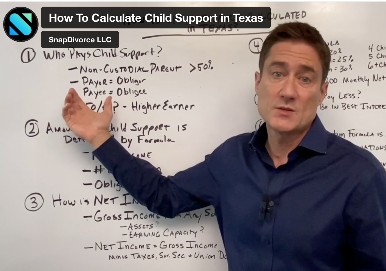
How Does Child Custody Works in Divorce?
How child custody works in divorce is complex. In this Divorce Academy video, Kevin explains what is really important in child custody cases and how they are resolved.
VIDEO TRANSCRIPT:
Hey everyone. Welcome back to Divorce Academy. I’m Kevin Handy, I’m one of the attorney mediators here at SnapDivorce and today we are going to talk about how custody works in divorce. We are going to give a broad idea of how it works. What are physical custody schedules? What is legal custody? What are some example custody schedules? We are going to go over all of that.
There are Two Types of Child Custody in Divorce: Physical Custody and Legal Custody
The first thing you should know is that there are two types of custody: physical custody and legal custody. Physical custody is what you think about when you think about custody. Where are the children going to be staying? Who’s watching the children at this time? When does my ex get to see the children? That sort of stuff. Legal custody has to do with who gets to make decisions about the children – major decisions- like where they are going to go to school, are they going to get surgery for appendicitis, that sort of thing. In 99% of cases, legal custody is going to be shared equally between the parties, so it’s not something you really need to worry about.
Physical custody is 95% of what custody is about, and it’s what your concern is going to be about. There are several different types of physical custody, there’s primary physical custody, there’s partial physical custody, equally shared custody, and there’s a visitation, or supervised visits.
Primary physical custody means that the party with primary physical custody has most of the time with the children. That means more than 50% of the time – more than 50% of the overnights with the children. So, if the children are staying at your house more than 50% of the time during the year, then you have primary physical custody.
Partial physical custody is kind of the opposite of primary physical custody. It means you don’t have primary physical custody and the kids are only staying at your house maybe 2/7 nights per week, something like that.
Equally shared, is kind of self-explanatory, you and the other parent have equal time with the children. Perhaps, you are doing a week to week schedule. Perhaps you are doing some sort of combination schedule. But overall, during the course of the year, you guys have equal time with the children.
Finally, there is visitation or supervised visits. Those are for unusual cases where someone has a drug or alcohol problem. Maybe someone has been convicted of assaulting the children. In those cases, the party with the problem is going to have very limited contact with the kids, and maybe they will have to have a supervisor. But this is pretty unusual, you are talking about serious problems with drugs or alcohol. You are talking about serious violence problems. A lot of people will come into the office and say, “oh I want the other parent to only have supervised visits” or “I just don’t like them” or “He’s a jerk” but that’s not going to cut it. It has to be really something serious.
There are 16 Factors Used to Determine Child Custody in Divorce in Pennsylvania
No matter what jurisdiction you’re in the court is going to look at a variety of factors that determines who gets primary custody, who gets partial custody, or should it be equally shared. In Pennsylvania where I am, there are 16 factors and it’s a really long list and each factor has multiple parts. I’m not going to list those here because in reality the courts not going to look at all those factors. No court is going to look through all those factors, no one is able to think about all of those things. What they do is they reference the factors to justify whatever decision they’re going to make. So, I don’t think you really need to know the factors but I did list a couple of them here in an abbreviated form just because I think they are kind of important.
Parental Duties: that means who assumed what parental duties while you were bringing up the kids together. Were one of you a stay at home parent? Did one of you do all of the sports with the kids? The courts will look at things like that. Preferences of the child: If you have an older child, which parent would the child prefer to live with? Drug and alcohol abuse: like I said before
The availability of the parties: who is available when to take care of the kids. Like I said, in Pennsylvania, there are 16 factors and I assume most other states have some sort of similar long list of factors. But I have here, what I call, “Kevin’s factors” and this is really what both you and your ex should base your decision on or if you go to court it’s probably what it’s going to base its decision on in determining who has custody when. I have 3 factors: practicality, status quo, and preferences of the child 12+ (12 years old, or older).
Practicality is – look when you’re raising a child, even if you are together in a relationship its hard work. You are always juggling schedules and saying, “oh can you take the kids to sports?” and “oh I have to work can you watch the kids today on their day off from school?” The same thing is going to happen when you and your partner have separated. Practicality is going to govern custody. If one of you works overnights, or one of you works a long distance away, or perhaps you travel for work. All of those things are going to guide you. That person is not going to be able to have custody when they are away- obviously. If someone goes to work early you are going to need the other parent to have the kids during that time. When you’re thinking about your custody schedule, think about your schedule, your exes schedule, where the kids need to be. That’s going to guide, again, 95% of how your custody schedule is going to come out.
Status quo- if parties can’t agree, what typically happens is the two parents will separate and move into two different residences, and the custody case hasn’t gone to court yet. The two parents are going to start to work out how they are sharing custody of the kids while they’re waiting to get to court. It’s really going to be guided by practicality- when you eventually get to court the court is going to say “Well you’re already doing this schedule, what’s wrong with that? You should just keep that in place, it seems to be working.” Status quo. Those two are going to interplay and sort of guide most of what’s going to end up being most of the custody schedule.
Finally, preferences if children 12+: even if you don’t have kids that are 12 years and older, you will eventually, as the kids grow up and the courts going to weigh more and more what the children want to do. Do they want to live at moms? Do they want to live at dads? They are going to want to be near their friends. That’s something to keep in mind.
How Child Custody Works in Divorce: Examples of Child Custody Schedules
Based on all of that I wanted to give you some examples of custody schedules that are pretty popular. There’s the week to week schedule – I wouldn’t say that’s super popular but for an equally shared custody schedule people do it, and it’s usually when they live further apart than normal. Most parents don’t want to go a whole week without seeing their kids. But if it’s far apart, or for older children, week to week tends to be popular. It’s pretty self-explanatory. One parent has from Saturday one week to one Saturday the next week, and then it flips.
Every other weekend, that’s probably less popular than it used to be, but it still works for a couple when one of the parents works a lot, travels, maybe they aren’t available that much. That parent will usually see the kids every other Friday to Sunday or every other Friday to Monday at school, something like that. Typically, during their off weeks, they will also have maybe every Wednesday night for a dinner visit. Maybe 5:00pm to 8:00pm.
In equally shared there are two pretty popular custody schedules. There’s one called the 2-2-5 and then there’s one called the 2-3 and I’ll explain each one. The 2-2-5 is based on the idea that one of the parents has the same two days every week, the other parent has the same two days every week and then they alternate the weekends. In this example, mom has every Monday and Tuesday – and by every Monday and Tuesday, I mean Monday and Tuesday overnight. So, maybe the kids come to moms after school on Monday and they stay Monday night, Tuesday night, they’re at school, and then they come to dads Wednesday after school. When I say days, I’m talking about where the kids are spending their nights. In the 2-2-5 mom has every Monday/Tuesday and dad has every Wednesday/Thursday and then the parties alternate Friday Saturday and Sunday.
Parents and kids like this schedule because it’s predictable. They know –I’m at moms every Monday/Tuesday and I’m at dad’s every Wednesday/Thursday and then I just alternate the weekends. It’s pretty easy to follow, the downside of it is that the kids end up being away from one parent or the other for 5 days at a time. If you look, one-week dad’s going to have Wednesday, Thursday, Friday, Saturday, Sunday. He has 5 overnights in a row and then it goes back to mom. The following week it’s going to be mom Monday/Tuesday, dad Wednesday/Thursday, and then mom Friday, Saturday, Sunday, Monday, Tuesday – now the kids are away from dad five days of the week. So, there are downsides to that.
A similar, but I would say a slightly better schedule if you’re willing to live with the slight unpredictability, is the 2-3. The idea for that is, it works on the same principle except that it just works in sequential order. Week 1 mom is going to have Monday/Tuesday, dad will have Wednesday/Thursday, then mom has Friday, Saturday, Sunday. Then in week 2 dad has Monday/Tuesday, instead of mom. Then mom has Wednesday/Thursday, instead of dad. Then dad has Friday, Saturday, Sunday. Then it goes back to week one, to mom. It just kind of works in order and that’s a very popular schedule.
Those are just some examples, but you have to figure out what works for your family. You can really do anything you want. I have some couples that will just say “look dad travels a lot, his schedule is really unpredictable, we’re just going to work it out. We will talk about it on a week to week basis when he’s going to be around and then we will figure it out like that.” That’s great if you guys get along. A lot of couples really don’t get along that well, and they say, “Hey you’re five minutes late, I’m going to call the police.” And in those examples, you’re really going to need a fixed custody schedule with fixed exchange times.
Child Custody Schedules for Holidays and Vacations
Holidays and vacations, those are split. Typically, Holidays are alternated every other year. For example, say Thanksgiving might be with dad in even years, years that end in even numbers like 2018 and 2020. Then Thanksgiving would be with mom in odd years, 2019, 2021, etc. Some holidays are split, like Christmas. People will divide Christmas in the middle. Maybe one year mom has Christmas morning and dad has Christmas afternoon, and then it flips.
Custody schedules also often include vacation time. Usually two weeks of nonconsecutive vacation.
How do you put it all together? You have an idea of what the custody schedule should be- vacations, holidays. Now you have to put it together, you have to come up with a written document to lay it all out and submit to a court order. You can come to an agreement and have a lawyer or a divorce mediator draft it. It is recommended that you don’t do it yourself because you really have to be specific and careful. You are going to have a divorce mediator or lawyer help you work it out, draft it up, and submit it to court. If you can’t agree- guess what- you’re going to be going to court. That might involve custody evaluations, and eventually, you’re going to get to a judge and the judge is going to impose a custody order on you. The judge will set the schedule if you and your ex can’t agree.
Common Pitfalls in Child Custody in Divorce
Finally, I just want to talk about some pitfalls in custody. Moving, that’s a big pitfall. When you and the other parent separate you should try and live relativity close to each other, in the same school district as the kids. The problem I see often is that maybe dad has a new girlfriend and he wants to be close to her, so he moves an hour away to be near his new girlfriend. Now, the kids don’t want to be there, mom is upset because the custody exchanges are difficult, and the court is not going to like it. It is highly recommended that you try and live in close proximity.
Micromanaging- that’s where one parent is always trying to tell the other parent what to do. You will see parents who send emails every other day about “you didn’t do this, you didn’t do that. You dressed the kids wrong. You’re not combing their hair right. You didn’t give them healthy food for breakfast.” It’s not going to work, it’s just going to upset the other parent, and when you go to court the courts going to be upset with you that you’re trying to micromanage the other parent. It makes you look really bad, so avoid micromanaging.
Nasty emails and texts- it’s pretty self-explanatory. When I consult with people for a custody case I always tell them, “Do not under any circumstances send a nasty email or text to your ex.” Don’t say “You’re an ass” You can imagine all of the things that people can say. So, don’t do it. Imagine every text and every email you send is going to be exhibit A at the custody trial. No one seems to be able to control themselves, but I’m just warning you do not send any nasty emails and text messages. Be polite.
Finally, just watch your social media use. It goes without saying, don’t post nasty things about your ex. Don’t post pictures of you drinking, or doing keg stands. Don’t say you’re not dating someone, and then have pictures of you at the beach with the person you say you’re not dating. Those sorts of things.
That’s pretty much it for how custody works in divorce. I hope this is helpful, and I will see you next time on Divorce Academy. Thanks!
Related Articles

Don’t blow
everything for
the sake of
revenge.
Find out how SnapDivorce® can help you simplify your divorce.


